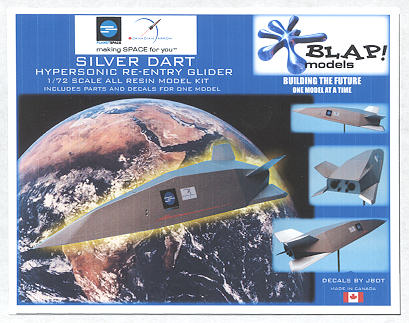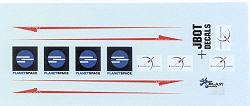
| KIT: | Blap Models 1/72 Silver Dart Hypersonic Re-entry Vehicle |
| KIT #: | ? |
| PRICE: | $65.00 from Blap Models. Includes shipping |
| DECALS: | One option |
| REVIEWER: | Scott Van Aken |
| NOTES: | Resin kit. |

| HISTORY |
“The Silver Dart is the DC-3 of the space industry,” said Geoff Sheerin, PlanetSpace president and CEO, in a telephone interview. “It has so many things going for it in terms of performance.”
Sheerin’s Silver Dart program is separate from his Canadian Arrow effort to use a proven V2 rocket design to build a three-person rocket ship for suborbital flights. Plans for the Silver Dart date back about four years as Sheerin was researching the Canadian Arrow rocket to compete in the $10 million Ansari X Prize competition for suborbital spaceflight.
“About five percent of my time has been looking and poring over the program,” Sheerin said of the Silver Dart plans.
But NASA’s intention to purchasecommercial services for both cargo and crew flights to the ISS encouraged Sheerin and his team to push forward with their work. NASA plans to retire its three remaining space shuttles – Atlantis, Endeavour and Discovery – in 2010.
Based on the U.S. Air Force’s Flight Dynamics Laboratory-7 (FDL-7) program, the Silver Dart is a lifting body designed to glide from hypersonic speeds of Mach 22 down to landing, PlanetSpace officials said. The spacecraft is expected to launch vertical atop a stack of about 10 Canadian Arrow rocket engines andland horizontally on an aircraft runway, they added.
The first Silver Dart spaceflight is expected follow the inaugural manned Canadian Arrow launches, the first of which is slated for 2008 with four more to follow, Sheerin said.
“You want to have a multitude of vehicles,” said PlanetSpace chairman Chrinjeev Kathuria. “With the Canadian Arrow, you’d want to enter the [spaceflight] market very quickly. The second stage is the Silver Dart.”
NASA based its X-24B test aircraft on the FDL-7 lifting body and valued the added range and stability the sleek, sharp-nosed design, according to documentation from the space agency’s Dryden Flight Research Facility in California.
Paul Cyzsz, an engineer who worked on the original FDL-7 effort and is guiding PlanetSpace’s Silver Dart work, said the new spacecraft would use a 1960-1970s era shell wrapped around a lighter inner body with updated, modern electronics.
“The advantage of an all metal aircraft is that you can land in any kind of weather,” said Paul Cyzsz, adding that unlike NASA’s space shuttle – which does not land in rain to prevent damage to its exterior. “You can’t trap it in space, it can always get back to the continental United States.”
Cyzsz said the FDL-7’s lifting body design would also give the Silver Dart about twice the lift coefficient as NASA’s space shuttles at subsonic speeds.
Background courtesy of www.space.com
| THE KIT |
 The kit comes superbly packaged in a sturdy box. The nose of the kit is protected with foam and the smaller parts are in a separate bag. None of the usual laborious clean-up is needed for this kit as all the stubs have been removed down to just a small area that will take but a few minutes to remove. The edges will also benefit from a quick swipe of a sanding stick. The resin is superbly molded with thin engraved panel lines on the fuselage. I did fine one tiny air pocket on the underside of a fin that will need to be filled and I also noted that one of the main rocket nozzle holes was filled more than the other so this will need a bit of grinding to get the nozzle to fit flush. These are trivial items that even the bare beginner will have little difficulty handling.
The kit comes superbly packaged in a sturdy box. The nose of the kit is protected with foam and the smaller parts are in a separate bag. None of the usual laborious clean-up is needed for this kit as all the stubs have been removed down to just a small area that will take but a few minutes to remove. The edges will also benefit from a quick swipe of a sanding stick. The resin is superbly molded with thin engraved panel lines on the fuselage. I did fine one tiny air pocket on the underside of a fin that will need to be filled and I also noted that one of the main rocket nozzle holes was filled more than the other so this will need a bit of grinding to get the nozzle to fit flush. These are trivial items that even the bare beginner will have little difficulty handling.
 The rest of the pieces were perfect and test fitting the fins and other nozzles showed that the fit is superb. The end result will be a model that is going to be pretty much trouble free to build. The kit includes a superbly molded display stand and a very nice set of JBot decals. Duplicates of all the markings are provided in case they are needed for these appear to be ALPS printed. This means they are quite thin and are easily scratched if one is not careful when handling them. The overall color is a silver and so you can use just about any silver paint you have, though it would be best to prime the model with a lacquer primer to assure good stick. The only thing the modeler needs to supply is a piece of metal rod to go between the stand and the model.
The rest of the pieces were perfect and test fitting the fins and other nozzles showed that the fit is superb. The end result will be a model that is going to be pretty much trouble free to build. The kit includes a superbly molded display stand and a very nice set of JBot decals. Duplicates of all the markings are provided in case they are needed for these appear to be ALPS printed. This means they are quite thin and are easily scratched if one is not careful when handling them. The overall color is a silver and so you can use just about any silver paint you have, though it would be best to prime the model with a lacquer primer to assure good stick. The only thing the modeler needs to supply is a piece of metal rod to go between the stand and the model.
| CONCLUSIONS |
July 2006
Review kit courtesy of Blap Models .Order yours direct.
.Order yours direct.
If you would like your product reviewed fairly and quickly by asite that has over 300,000 visitors a month, please contactme or see other details in the